- Assignment Groups

How Do I Use Assignment Groups in Canvas?
In Canvas, assignment groups allow you to organize your assignments into discrete groups. For example, you may want to group all the essay assignments in your course within one assignment group titled ‘Essays’.
Assignment groups allow you to leverage a weighted grade scheme in your Canvas course. A weighted grade scheme allows you to distribute percentages of a student’s final grade across these assignment groups. Following our previous example, you may want the Essays group to account for 30% of the final grade.
By default, Grade weighting is turned off for all Canvas courses. To turn on Grade weighting, please follow Canvas’ tutorial for weighting final grades based on Assignment Groups.
How do grade weights get distributed across an Assignment Group?
In Canvas, the weight of an assignment group is distributed proportionally across the assignments inside it. Because of this, assignments worth different points will be weighted differently if they are in the same assignment group.
Here’s an example of an assignment group in Canvas. This group is worth 30% of the total grade and contains three assignments with different point values. The table further below outlines how the assignment group weight of 30% is distributed across the three Assignments.
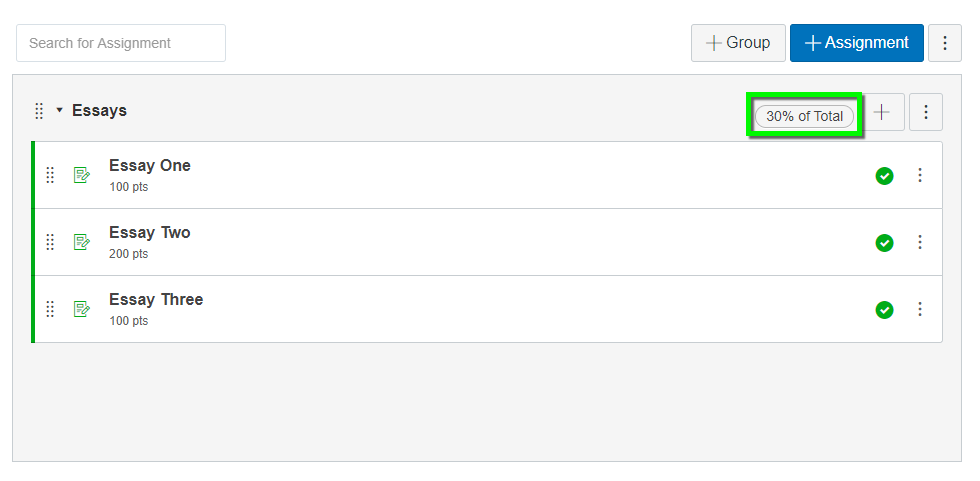
Here, since Essay Two is out of 200 points, it will count two times more than Essays One and Three.
| Assignment | Point Value | Proportion | Weight (% of grade) |
|---|---|---|---|
| Essay One | 100 | 100/400 total points | .25 * 30% = 7.5% |
| Essay Two | 200 | 200/400 total points | .50 * 30% = 15% |
| Essay Three | 100 | 100/400 total points | .25 * 30% = 7.5% |
***assignment group weight distribution for assignments with differing point totals.
If you want all assignments within a given assignment group to be worth the same weight, you have two options:
1. Make all assignments inside an assignment group worth the same number of points, as shown below.
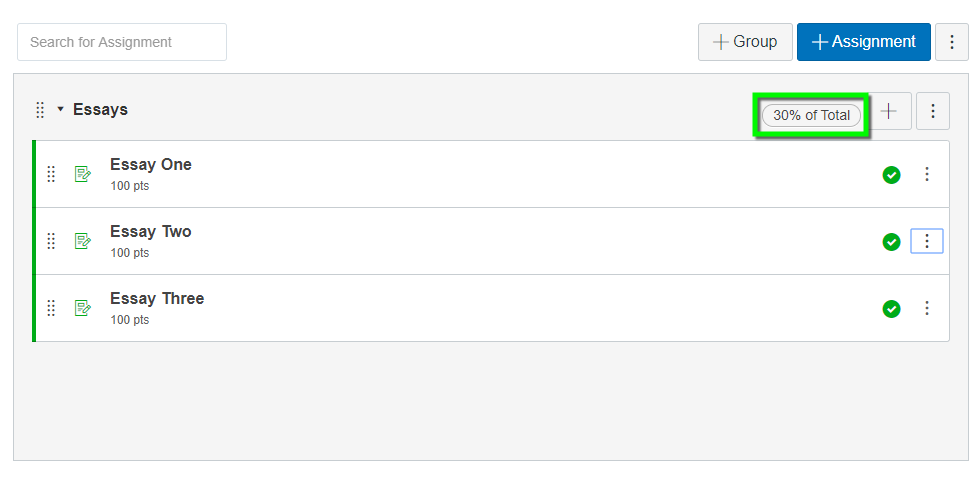
***In this scenario, we have changed Essay Two’s point value from 200 to 100 points. Since all point values in this assignment Group are the same, each Assignment will be worth the same, 10% in this case.
2. Create new assignment groups for any outlier assignments if you cannot or do not want to change their point value.
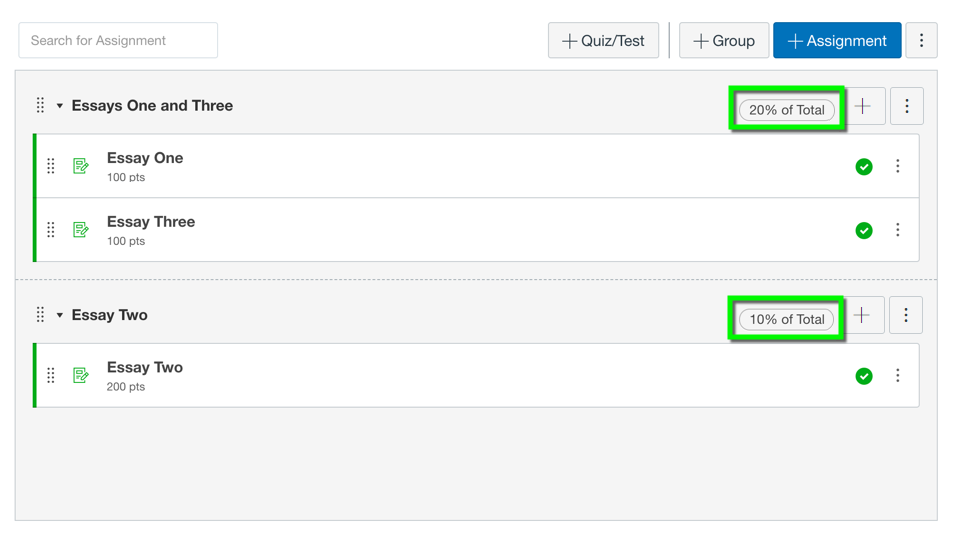
***In this scenario, we have not changed Essay Two’s point values, so we will need to put it in its own assignment group worth 10% and change the first assignment group to be worth 20% so that all Essays are now worth 10% of the total grade.
- Voice Conferencing
- Getting Started
- AI Companion
- Common Good License Request
- License Purchase Request
- App Marketplace
- Canvas Integration Guide
- Secure Meetings Guide
- No Fixed Time Meetings
- Known Issues
- Accessibility
- Academic Technology Training
- Consultation Request
- Group Training Request
- Cloud Computing in the Classroom
- Turnitin Review Project
- Campus Perceptions of Lecture Capture
- Online Proctoring Needs Assessment
- Meet Our Team
- Accessibility and Usability Lab
- Project Information FAQ
- Container Platform
- COVID-19 Site Access Guidelines
- Sustainability
- Remote Hands Service
- Request for Information
- Rules and Guidelines
- Data Services
- 2022/2023 Service Changes
- Desktop Support Features
- Active Directory at CU Boulder Delegated OU Information Sheet
- Facilitating Remote Work & Support
- Moving to DDS
- Service Level Agreement
- Service Request Portal
- Radio Request or Support
- Learner Lifecycle Constituent Relationship Management Team
- Messaging & Collaboration Team
- Software Engineering
- Maintenance Schedules
- Support Definitions & Response Time
- Install Red Hat End User Site License
- Redhat 8: Join Active Directory
- Requesting Escalated Access
- Virtual Infrastructure Policies
- Testimonials
- Virtual Server Request
- External Linux Support Changes
- User Experience Team
- Access Management
- Basic Access Management
- Managing Permissions
- Retrieve a File
- Tips & Tricks
- UCB Files Request
- Request a shared folder
- How to Encrypt Files Before Sharing
- Physical Servers
- Virtual Servers
- Report an Incident
- Artificial Intelligence (AI) Data Security Guidelines
- Definition of Terms
- Remote Work Guidance
- Identify & Report Phishing Emails
- Password Managers
- Risk Acceptance and Temporary Security Exceptions
- Security Training for ITSP
- Request Firewall Exception
- Request SSL Certificate
- IdentiKey Manager
- Account Provisioning & Activation
- Request Form
- Digital ID Attributes
- RFP Guidance
- Microsoft 365 Multi-Factor Authentication
- Microsoft Entra
- Auxiliary AV Service Request
- Find or Reserve a Lab
- Liaison List
- Software Additions & Modifications
- Labs Homepage
- OIT Cloud Applications
- Remote Access
- Download Software
- Attendance-Only Feature
- Equipment Checkout
- Frequency & Wireless Ratings
- How to Onboard Your Students
- Pedagogical Resources
- Wireless Considerations
- Student Resources
- Distance Learning Studios Transition Resources
- How to Print with wepa
- Learning Spaces Technology Classroom Standards
- Training Videos
- Classroom Standards Equipment List
- Technology Equipped Classrooms List
- Hybrid-Capable Classrooms List
- Hybrid Work Recommendations - Your Meetings
- Zoom Web Conferencing
- Technology Copilots Request
- Use your Google Group as an email list
- Manage your Google Drive usage
- Review and save Google Drive files
- App Descriptions
- Enabling Apps for Campus
- Google Migration Dashboard
- Alumni Changes to Microsoft and Google
- Faculty, Staff, and Student Gmail Migration
- Google Drive Migrations
- Google Shared Drive File Migrations
- Outlook on the web - Email & Calendars
- Calendaring Best Practices
- Request Exception
- Retention Policy E-memo
- Resource Display Name Format
- FindTime Add-In
- Manually Move Mail from Gmail to Microsoft 365
- Desktop & Mobile Apps
- Office 365 Online
- Prepare your data for OneDrive on macOS
- Departmental Intranet Site
- Microsoft Copilot for Bing Chat Enterprise
- Microsoft Loop
- Collaboration and File Storage
- Guest & External Users
- New Microsoft Teams Client
- Sharing channels with people outside of CU Boulder
- Viva Insights
- Resource Library
- Office Online
- Administrative E-memo
- Course Roster Email
- Exchange Distribution Lists
- Email & Calendaring Direction
- External Email Tag FAQ
- Email Attachments
- Request an SMTP Exception
- Email Forwarding
- Reauthentication Issues
- Service Guidelines
- Troubleshooting
- Interference Sources
- Tips and Tricks
- Network Registration
- Clear the Browser Cache
- Technical Details
- Foundational Services and Connectivity
- Always on VPN
- Advanced/Server Admins
- How It Works
- Usage Policy
- Security & Regulations
- IP Address & Hostname Management
- Dynamic DNS
- The Preserve
- Software Catalog
- Acquiring Software
- Appropriate Use and Compliance
- Software Asset Management Program
- Software Audit Information
- Recording a Lecture or Event
- Sound and Microphones
- Your Recordings
- Analytic Reports Overview
- Request Classroom Capture
- Reactivate Previously Recorded Content
- Community Course Request
- Sandbox Course Request
- Accessible Content Structure
- Creating Accessible Quizzes
- Providing Extended Time Accommodations
- Rich Content Editor Accessibility Checklist
- New Analytics
- Course Access Report
- Interactions Report
- Feature Options
- Cidi Labs Design Tools (Pilot)
- Example Courses
- New DesignPlus Sidebar
- Latest Updates
- Enhancements
- Mobile Apps
- Grade Schemes
- Designing for Student Comprehension
- Dropped Students FAQ
- Getting Started with Canvas
- Roles and Permissions
- Testing and Assessment Center Instructions
- Using Announcements and Inbox to Communicate
- Reviewing Migrated Content
- Student Support Videos
- Start of Term FAQ
- End of Semester Best Practices
- Automatic Course Creation
- Profile Pictures
- Canvas Scheduler vs. Microsoft Bookings
- Coursera Learning Programs
- Terms of Use
- Canvas Integration
- Kaltura Retirement Information
- Kaltura and Canvas Studio Comparison
- Open Researcher & Contributor ID (ORCID)
- Suggested Syllabus Statement
- Student FAQ
- Privacy Information
- SensusAccess
- Student Data and OIT Services
- Syllabus Archive
- Instructor Account Request
- Using Turnitin with Canvas
- Request a Pro Account
- Student Guide
- Channel Lineup
- Scan for Channels
- Teams Calls Support Form
- Long Distance
- Basic Functions
- Phone Interface
- Voice/Data Service Request
- Support Form
- Connect to the Server
- Password Protect Web Pages
- General Permissions Guide
- Online Manual
- Local Unix Conventions
- vi Commands
- Spot and Rintintin Personal Sites
- SSL Certificates
- Application Information Form
- Projects & Partners
- Staff Resources
- Our Practices
- Style Guide for Campus Communications
- Recommendations for Student Administrators
- Python - Install modules without root access
- Offline Surveys App
- Accessibility Exception Request
- Applications & Modules
- UI Indicators
- Explanation
- Known Issues & Updates
- Manage Success Team
- Dashboards & Reports
- Onboarding New Staff
- Configuring Criteria
- Student Success Staff
- Course Alerts
- GitHub Enterprise
- Jira Software
- Paperless Campus
- Convert a File
- Acquire Software & Hardware
- Standard Computer Peripherals
- Standard Computers
- Department Labs
- Student Shopping List
- Linux Support
- Crowdstrike vs. Microsoft Defender Comparison
- Endpoint Guide Mac
- Endpoint Guide Windows
- Privacy & Software Transparency
- Nudge for macOS Updates
- iOS Patching
- Windows Patching Process
- Self Service Software
- Software Lifecycle
- Software News, Events, and Announcements
- Your Microsoft Products and Services
- Ordering Exception
- Ordering and Reimbursement
- Request for Reimbursement
- Standard Models List
- Multi-Function Device Setup
- Faculty, Staff, and Retirees
- Microsoft Entra ID
- Secondary Accounts
- Sponsored Affiliates
- Purpose & Mission
- Buff Techs Desktop Support
- Getting Started with Campus Technology
- Fall 2020 Technology and Requests Survey Report
- Instruction Modes & Technology Mapping
- Tips for Recording Lectures from Home
- Remote Learning Guidance for Students
- Your Computer
- Hybrid Meeting Technology Best Practices
- Your Productivity and Collaboration
- Your Network Access
- Retirees Access to Microsoft and Google Access
- LinkedIn Learning
- 2022 - 2023 Strategic Priorities & Goals
- Initiative: Cloud Computing for Research and Teaching at CU Boulder
- OIT Group Profiles
- Survey Results
- Offenders/Alternatives
- Report Abuse or Harassment
- Account Lifecycle Project
- Cisco Transition to Teams Calls
- Google Storage Project
- Major Projects & Service Direction
- Microsoft Office Licensing Remediation Project
- SPSC N190 Transition Project
- Secure Computing Project
- Administrative
- Subscribe to Service Alerts & News
- Update Your Contact Information
- Service Alerts

Search Utah State University:
Canvas assignment groups.
The Assignments page is arguably the most central to successful Canvas course utilization.
- It controls the columns in the gradebook and gradebook calculations.
- It displays all things gradable, including assignments, gradable discussions, and quizzes. Each can be created in Assignments.
- Dates used in the syllabus and calendar are rapidly edited in Assignments.
Use assignment groups to achieve:
- Assignment categorization
- Drop lowest n scores
- Drop highest n scores
- Never drop x assignment
- Weighting of grades
Canvas creates a group called "Assignments" by default, but you can change the group title or create additional groups. Because the default group is Assignments, Canvas places all assignment types into that group. When you are creating a new assignment, graded discussion, or quiz you will have the option to designate it as belonging to a previously created assignment group.
On This Page
Create an Assignment Group
Move an assignment between groups, weighting assignment groups, video tutorial, assignment page icons, filter the gradebook by assignment group.
On the Assignment page, click + Group

In the Add Assignment Group box, type the name of the group and click Save
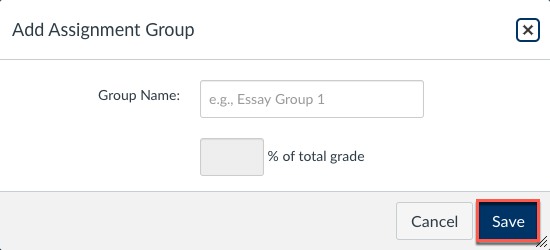
Click on the double column of dots next to an assignment and drag to a new group.
Or, click on the three dots to the right of the assignment and click on Move To... then choose the desired assignment group and location.
Click on the assignment settings, then choose Assignment Groups Weight from the menu
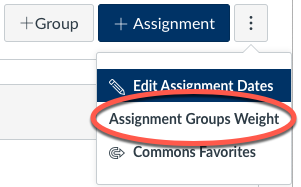
Check the box to "Weight final grade based on assignment groups" and then enter the percentage assigned for each group
(weights should typically equal 100, but can exceed 100 for extra credit)
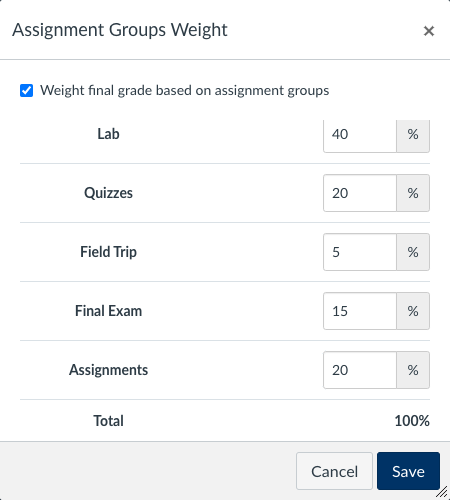
This short video will walk you through the process of creating weighted assignment groups in your Canvas course.
| Icon | Description |
|---|---|
| Drag and drop assignments and assignment groups to desired locations | |
| Options menu | |
| Edit assignment or assignment group | |
| Add an assignment or assignment group | |
| Delete an assignment or assignment group |
On the Grades page, click on the View dropdown menu and choose the Filters option
Then, select Assignment Groups from the menu
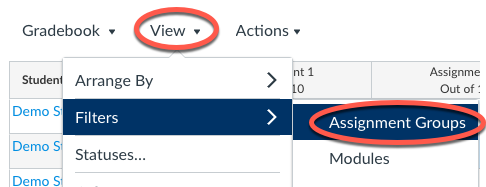
A new dropdown menu will appear at the top of the page
Click on All Assignment Groups to select a certain group of assignments you would like to see

March 19: New Look for Duo Two-Step Authentication Prompt. More Info.

New to OIT Service Center? Register for an account
Create weighted assignment groups in canvas for grading - knowledgebase / teaching learning and research / canvas / assessments and grading / assignments - oit service center.
- Download PDF
Copy to Clipboard
Create weighted assignment groups in canvas for grading.
- cb christine brown
- ej edwin jeng
- mv maggie vecchione
- MK Melissa Kane
- rt rebecca taub
- Last updated: Jul 3, 2023 by Claire Streckenbach
When you have different assignment types (e.g., assignments, discussions, quizzes, etc.), and a weighted grading system, you may use Canvas’ Assignment Groups to calculate weighted grades and organize the assignments. Based on the information you’ve articulated in your syllabus, you can quickly set up Assignment Groups.
Create Assignment Groups
- Log in to Canvas at canvas.brown.edu and select your course from the Global Navigation menu on the left.
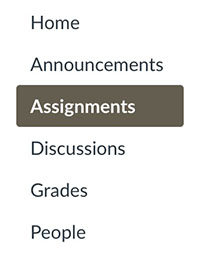
| The Assignments page lists all the assignments you have created for your course and their respective assignment groups. You can edit, delete, and add assignments as well as assignment groups. Assignments in your course navigation, but you will still navigate there to set up Assignment Groups. |
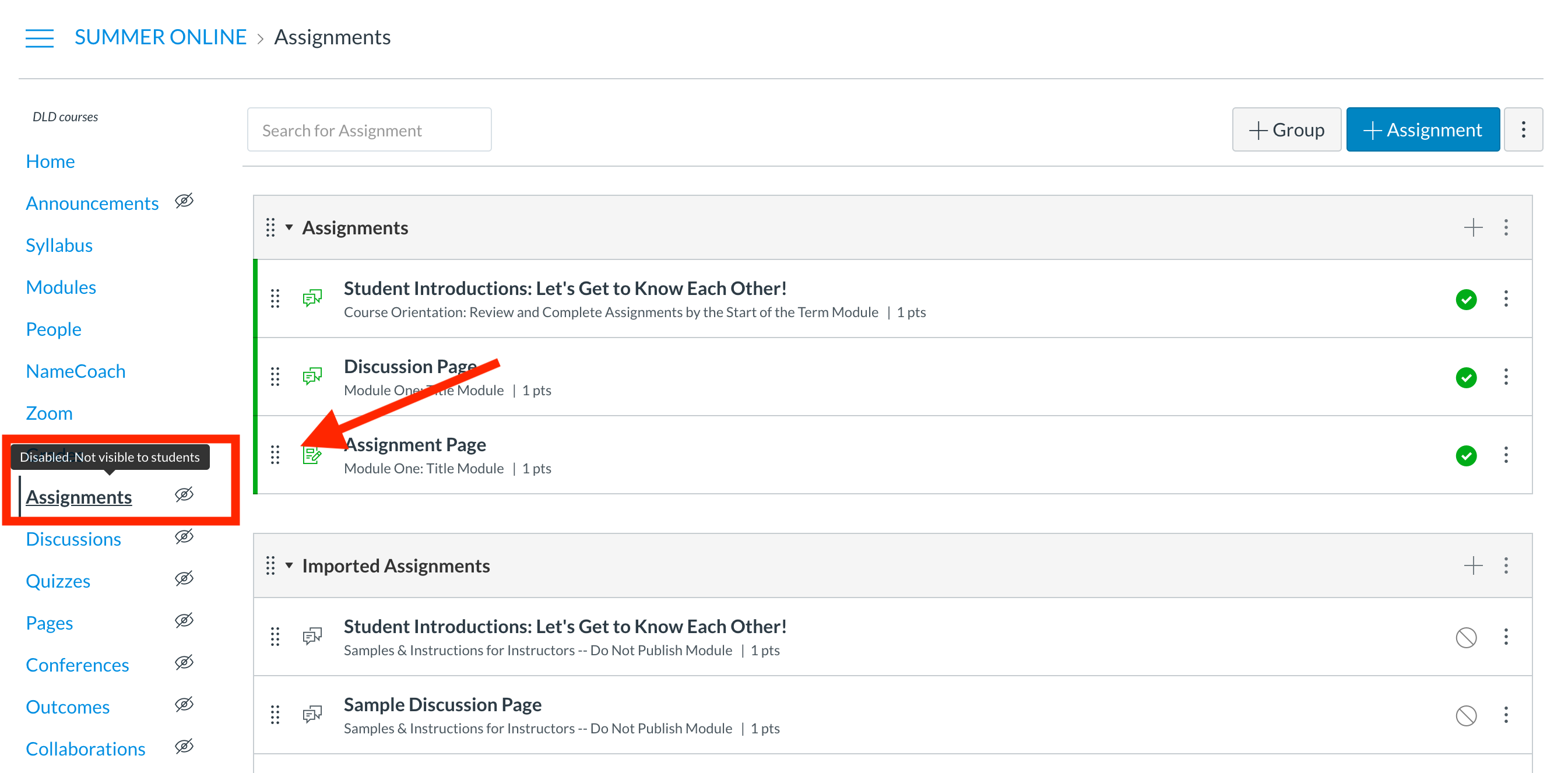
Create an Assignment Group

- Enter the name of the assignment group in the Group Name box.
- Enter the percentage of the total grade in the % of total grade box. You can leave the box empty and/or change the number later.
- Click Save .
Create Weighted Assignment Groups for Grading

| You have to first create your assignment groups to use this option. |
- Enter the percentage of the total grade for each assignment group in their respective % boxes.
- Make sure the Total is 100%.
- Click Save.
Note: You have to first create your assignment groups to use this option. |
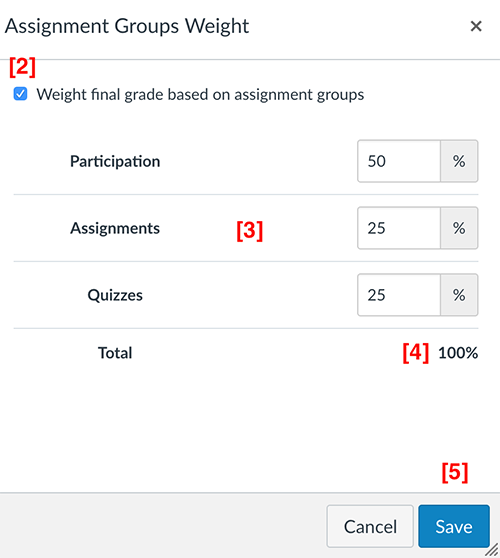
Manage Assignment Groups

| : In the window that appears, you can define various grading rules. |
- Edit the Group Name and % of total grade in their respective boxes.
- Enter the number of scores to drop from each student's final grade in the Lowest Scores and Highest Scores boxes.
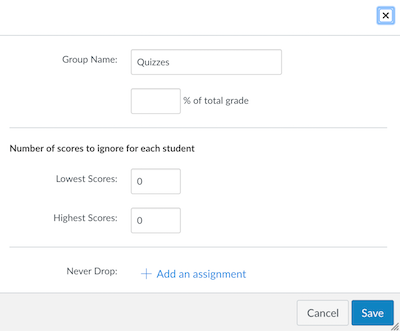
- To reorder an assignment group in the Assignments page, click and drag the assignment group.
- To delete a group, click the Edit (gear) icon to the right of the group name, then click Delete . You can delete the assignments within the assignment group or move them to another assignment group.
For more information on Assignment Groups, please see the following link: . |
247 of 450 people found this page helpful
Send us a note about this article
Related Content
- Create & Customize Canvas Assignments
Contact the OIT Service Center
Phone: 401-863-4357
Email: [email protected]
Location: Page Robinson Hall - 69 Brown St., Room 510
See our availability
https://it.brown.edu/get-help
Walk-ins Welcome! Appointments recommended.
For reserved service for a technical consult or a loaner check-out, you can schedule an appointment here .
Reporting an IT Outage?
Report an Outage
Service Status & Alerts Phishing Warnings

University Center for Teaching and Learning
How to create assignments for your canvas course.
- Quick Start
- Instructor Help
- Student Help
How to Create Assignments
Using assignments in Canvas provides a streamlined process for assigning homework and creating quizzes for students. Canvas considers an ‘assignment’ to be anything that is graded, whether that be a quiz or homework assignment, and whether it’s delivered entirely online, paper-and-pencil, or is a participatory assignment with no actual deliverable.
This Quick Start guide will cover the creation of assignments where the student submits a file electronically, on paper, using an external tool such as Turnitin or Panopto , or where no submission is expected (e.g. class participation). See How to Create Tests and Quizzes for Your Canvas Course and Create and Manage Discussions for more information about using those tools as assignments.
1. In the Course Navigation menu, click the Assignments link.

2. Click “ +Assignment ” at the top right.

3. Write the assignment title and directions for students.

4. Assign the number of points available for the assignment.

5. Choose an “ Assignment Group” . Assignment groups are, in essence, a category of assignment. For more information about using Assignment Groups, see the Canvas guides regarding Assignments.

6. There are four submission types :

- No Submission: an activity where nothing will be collected from students (e.g. a participation grade)
- For the full details about the online assignment subtypes, (text entry, annotation, file upload, etc.), please see the official documentation .
- We have a recorded mini-webinar on annotation assignments, including assignment ideas, available on the Training Webinars page.
- On Paper: assignments/quizzes/activities that were written on paper and collected by the instructor
- External Tool: assignments submitted through a 3rd party tool that is integrated with Canvas, such as a textbook publisher’s website or Turnitin
7. Submission Attempts: You may allow unlimited submission attempts for Online assignments, or restrict attempts to one or more. When a student submits to an assignment they have already submitted to, the previous submission is retained as well, and the instructor may view both.
8. Group Assignments and Peer Reviews: Assignments can be created as either a group assignment or peer review assignment.
9. Assign options- You can assign an assignment to your entire class, a specific student, and/or a section of your class. You can also set the due date and the availability dates (when your students can submit their assignment). Each section can have different due dates and availability dates.

10. If you are finished creating the assignment, click on “ Save & Publish “. If you are not finished creating the assignment, click on “ Save ” and you may come back and work on it more later without students having access to it.

Instructor Help for Assignments
Creating assignments.
- How do I create an assignment?
- How do I add a moderated assignment to be graded by multiple reviewers?
- How do I create an online assignment?
- How do I add or edit details in an assignment?
- How do I add or edit points for an assignment?
- What assignment types can I create in a course?
- How do I limit submission attempts for an assignment?
- How do I add an assignment that includes anonymous grading?
- How do I enable anonymous instructor annotations in student submissions?
- How do I import SCORM files as an assignment?
- How do I publish or unpublish an assignment as an instructor?
Managing Assignments
- How do I use the Assignments Index Page?
- Can a student resubmit Canvas assignments?
- How do I assign an assignment to everyone in a course?
- How do I assign an assignment to a course group?
- How do I assign an assignment to a course section?
- How do I assign an assignment to an individual student?
- How do I view differentiated assignments with different due dates in a course?
- How do I bulk update due dates and availability dates as an instructor?
- How do I delete an assignment?
- How do I duplicate an assignment?
- How do I move or reorder an assignment?
- How do I use Direct Share to copy an assignment to another course?
- How do I use Direct Share to send an assignment to another instructor?
Creating and Managing Peer Review Assignments
- How do I create a peer review assignment?
- How do I use peer review assignments in a course?
- How do I automatically assign peer reviews for an assignment?
- How do I manually assign peer reviews for an assignment?
- How do I view student peer review comments as an instructor?
Creating External Tool Assignments
- How do I add an assignment using an external app?
- How do I create a cloud assignment with a Microsoft Office 365 file?
Using Assignment Groups
- How do I add an assignment group in a course?
- How do I create an assignment shell in an assignment group?
- How do I create rules for an assignment group?
- How do I move or reorder an assignment group?
- How do I weight the final course grade based on assignment groups?
Grading Considerations
- How do I add a grading scheme to an assignment?
- How do I download all student submissions for an assignment?
- How do I upload all student submissions for an assignment?
- How do I exclude an assignment from the course’s final grades?
- How do I give extra credit in a course?
Student Help for Assignments
- How do I view Assignments as a student?
- How do I filter assignments by type as a student?
- How do I submit an online assignment?
- How do I submit a text entry assignment?
- How do I enter a URL as an assignment submission?
- How do I submit a media file as an assignment submission?
- How do I upload a file as an assignment submission in Canvas?
- How do I upload a file from Microsoft Office 365 as an assignment submission?
- How do I know when my assignment has been submitted?
- How do I manage celebration animations in Canvas as a student?
- How do I submit a cloud assignment with Microsoft Office 365?
- How do I download assignment submissions from all my courses?
- How do I annotate a file as an assignment submission in Canvas?
- How do I use DocViewer in Canvas assignments as a student?
- How do I submit a PDF assignment with annotations in the Student app on my Android device?
- How do I add annotations to a submission in the Student app on my iOS device?
Groups and Peer
- How do I submit an assignment on behalf of a group?
- How do I know if I have a peer review assignment to complete?
- How do I submit a peer review to an assignment?
- Where can I find my peers’ feedback for peer reviewed assignments?
- How do I view the rubric for my assignment?
- How do I view the rubric for my external tool assignment?
- How do I view rubric results for my assignment?
- How do I know when my instructor has graded my assignment?
- How do I view assignment comments from my instructor?
- How do I view annotation feedback comments from my instructor directly in my assignment submission?
- How do I view my Roll Call Attendance report as a student?
- Virtual Q&A: 2024 Provost’s Award for Diversity in the Curriculum
- Generative AI Resources for Faculty
- Student Communication & Engagement Resources
- Pre-course Surveys
- Teaching Consultations
- Equipment Loans and Rentals
- Report a Classroom Problem
- New Requirements for Accommodated Testing
- Workshops & Events
- New Faculty Essentials
- Not sure what you need?
- Accessibility Resource Hub
- Assessment Resource Hub
- Canvas Resource Hub
- Center for Mentoring
- Creating & Using Video Resource Hub
- DEI Resource Hub
- General Pedagogy Resource Hub
- Graduate Student/TA Resources
- Remote Learning Resource Hub
- Syllabus Statements & Checklist
- Student Communication & Engagement Resource Hub
- Technology & Equipment Resource Hub
- Classroom & Event Services
- Assessment of Teaching
- Classroom Technology
- Custom Workshops
- Open Lab Makerspace
- Pedagogy, Practice, & Assessment
- Need something else? Contact Us
- Educational Software Consulting
- Learning Communities
- Makerspaces and Emerging Technology
- Mentoring Support
- Online Programs
- Teaching Surveys
- Testing Services
- In-Class Video Services
- Media Creation Lab Podcast
- Video Production
- Assessment and Teaching Conference
- Diversity Institute
- New Faculty Orientation
- New TA Orientation
- Teaching Center Newsletter
- Meet Our Team
- About the Executive Director
- Award Nomination Form
- Award Recipients
- About the Teaching Center
- Annual Report
- Join Our Team

You're signed out
Sign in to ask questions, follow content, and engage with the Community
- Canvas Instructor
- Instructor Guide
How do I create rules for an assignment group?
- Subscribe to RSS Feed
- Printer Friendly Page
- Report Inappropriate Content
in Instructor Guide
Note: You can only embed guides in Canvas courses. Embedding on other sites is not supported.
Community Help
View our top guides and resources:.
To participate in the Instructure Community, you need to sign up or log in:
Getting Started with Canvas Assignments
- Last modification date Updated On July 26, 2024
- Categories: Assignments , Canvas , Uncategorized
- Categories: assessment , Getting Started , Grading

Canvas Assignments are a way for instructors to provide students opportunities to practice using the knowledge and skills they have gained or to assess student performance related to such knowledge and skills. (Creating an Assignment is the only way to create a new column in the Gradebook.)
In Canvas there are four basic Submission Types for assignments. The submission types include:
- No Submission : For assignments for which you are not collecting any content from the students.
- Text Entry : For students to enter text directly into a text box on Canvas.
- Website URL : For students to enter a URL (usually to a blog, video, podcast, etc.).
- Media Recordings : For students to upload or record media for submission.
- File Uploads : For students to upload files for submission ( Restrict Upload File Types will allow you to limit which types of files may be submitted).
- On Paper : For assignments students will submit in person.
- External Tool : For assignments which students will submit through a third-party tool (such as Turnitin, Panopto Video Quiz, and PlayPosit).
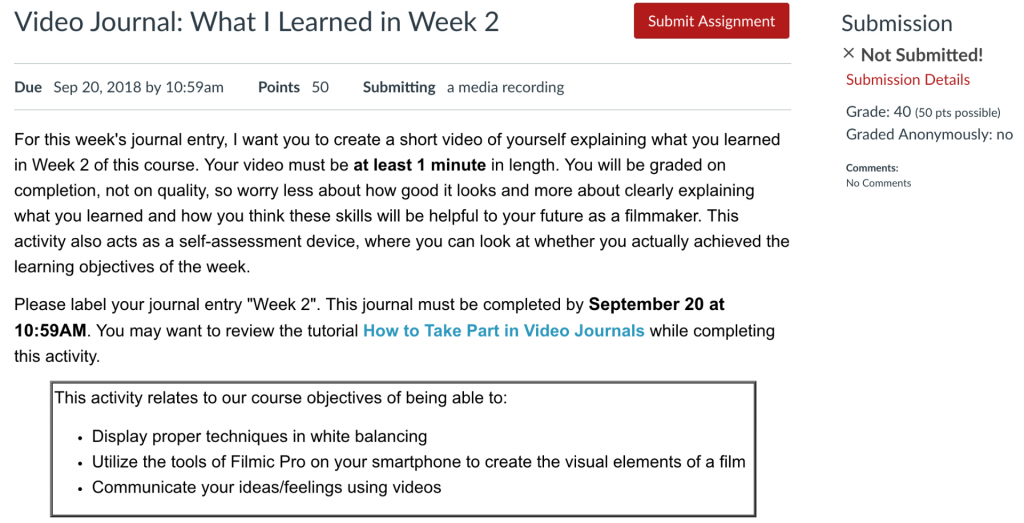
Managing an Assignment
Managing assignment groups.
When getting started with Assignments, learn to
- Create an assignment shell with the Canvas guide How do I create an assignment?
If you select Peer Reviews Appear Anonymously , annotation tools in SpeedGrader will become unavailable.
If you change the Assign To area from Everyone to select students after submissions have already begun, and do not have a second set of Assign To dates, submissions from unassigned students will disappear.
- Published assignments are visible as existing outside of availability dates, but students cannot see the details.
- If looking to update the due and/or availability dates on multiple assignments, see How do I bulk update due dates and availability dates as an instructor?
- If choosing the option to make an assignment a Group Assignment : If only assigning to specific groups, make sure to click the X on the Everyone Else choice under Assign to .
Media Recording Assignments are not recommended due to technical reasons. Instead, have students submit media by embedding it in a Text Entry assignment through Panopto .
Clearly express expectations and criteria for grading by using a Rubric .
Be cautious limiting submission attempts, as students often make mistakes loading documents and need multiple attempts to ensure you have the correct submission.
- Delete an assignment with the Canvas guide How do I delete an assignment?
- This duplication process will not work for Quizzes.
- Attach a rubric to an assignment for grading or to communicate expectations to students with the Canvas guide How do I add a rubric to an assignment?

Accessibility Tips
- Use descriptive text for links, instead of long URLs or ‘click here’.
- Make instructions brief and to-the-point. Avoid long paragraphs and sentences.
- Consider allowing multiple submission types to accommodate technical limitations students may face.
Assignment Groups are a way to categorize different graded items in Canvas. For example, you may have journals, blogs, and essays which your students create in your course. Assignment Groups allow you to label and group different types of assignments separately in order to better organize and for ease when applying weighting (see How do I weight the final course grade based on assignment groups? ). When getting started with Assignment Groups, learn to
- Add and delete assignment groups with the Canvas guide How do I add an assignment group in a course?
- Move or reorder an assignment group with the Canvas guide How do I move or reorder an assignment group?
- Make rules governing grading expectations within assignment groups with the Canvas guide How do I create rules for an assignment group?
Additional Resources
- CTI Resource: What is the Assignments Index Page?
- How do I bulk update due dates and availability dates as an instructor?
- How do I weight the final course grade based on assignment groups?
- Canvas Student Guide

Subscribe By Email
Get a weekly email of all new posts.
Your Email Leave this field blank
This form is protected by reCAPTCHA and the Google Privacy Policy and Terms of Service apply.
You are using an outdated browser. Please upgrade your browser to improve your experience.

E-Campus Faculty and Staff
How-to: set up weighted grades in canvas gradebook.

By: Gracia Ostendorf
Setting up weighted grades in canvas.
Canvas uses what are called “Assignment Groups” to organize assessments, and view grades, in different groups. You can create groups for different types of activities (i.e. all Discussions, all Quizzes, etc.), different units or modules of your course (i.e. a Unit 1 group with a Unit 1 Discussion, Unit 1 Quiz, etc.), or any other way that may be appropriate for your course setup and grading scheme. Your groups can then be weighted with different percentages to determine students’ final grades.
To Create an Assignment Group in Canvas:
- Click the “+ Group” button to create a new Assignment Group
- Add existing Assignments to the Groups by dragging and dropping them on the Assignments page
- Clicking the “+” button in the group header
- Clicking the “+ Assignment” button and selecting the group in the ”Assignment Group” dropdown on that Assignment’s edit page
- Each Assignment Group will be represented with its own column in the Canvas Gradebook (found by clicking “Grades” in the left-hand menu of your Canvas course)
To Assign Weights to Assignment Groups in Canvas:
- On the “Assignments” page, click the 3 dots in the upper right-hand corner of the page, and click “Assignment Groups Weight”
- Check the box next to “Weight final grades based on assignment groups”
- Specify the percentage for each Assignment Group, then click “Save.” These percentages will be reflected in the group headers on the Assignments page, as well as the group columns in the Gradebook
- To edit these percentages, as well as other options like ignoring a certain number of high or low scores from an Assignment Group, click the 3 dots in the right-hand corner of an Assignment Group header, and click “Edit”
You may also be interested in:

We've Got Your Back
If at any point you would like support or guidance while you are teaching a distance learning course, please connect with us! We are here to help.
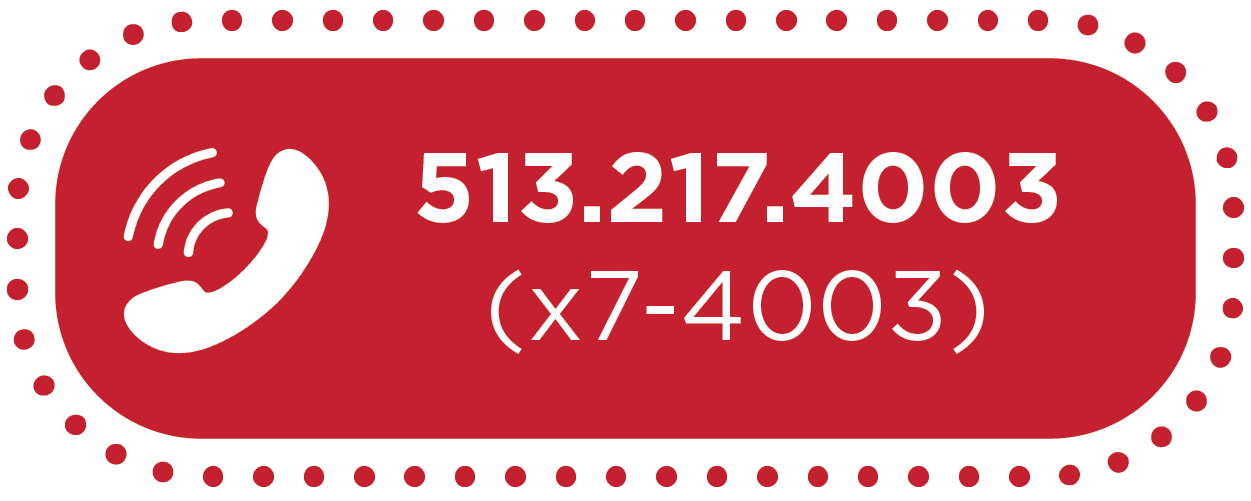
Use Weighted Assignment Groups in Your Canvas Course
by Thomas Keith | Aug 26, 2022 | Canvas , Canvas Features/Functions , How-tos , Pedagogy

Introduction
- Create an Assignment Group
Weight Assignment Groups
Use weighted assignment groups to calculate the total grade, drop a low score from an assignment group, further resources and getting help.
It is good pedagogical practice to maintain a Canvas Gradebook that gives an accurate reflection of your students’ performance. Students frequently consult their grades in Canvas to get a sense of how they are doing in your course and of areas in which they need to improve. You can use weighted Assignment Groups in your Canvas course to help ensure that the grade calculated by Canvas is indicative of students’ actual performance.
Create An Assignment Group
An Assignment Group in Canvas is a means of sorting assignments according to the categories to which they belong in your syllabus. By default, new assignments created in your Canvas course will be added to a catch-all group called Assignments . (Note that “assignments” in this context refers to anything that is graded; this can be an Assignment proper, a Quiz, or a graded Discussion.)

You can create a new Assignment Group by going to the Assignments tab in your course and clicking the gray +Group button at the upper right.

It is a good idea to give your group a name that reflects the assessment categories on your syllabus. For example, if the group contains quizzes that are given each week of the quarter, you might call it Weekly Quizzes .
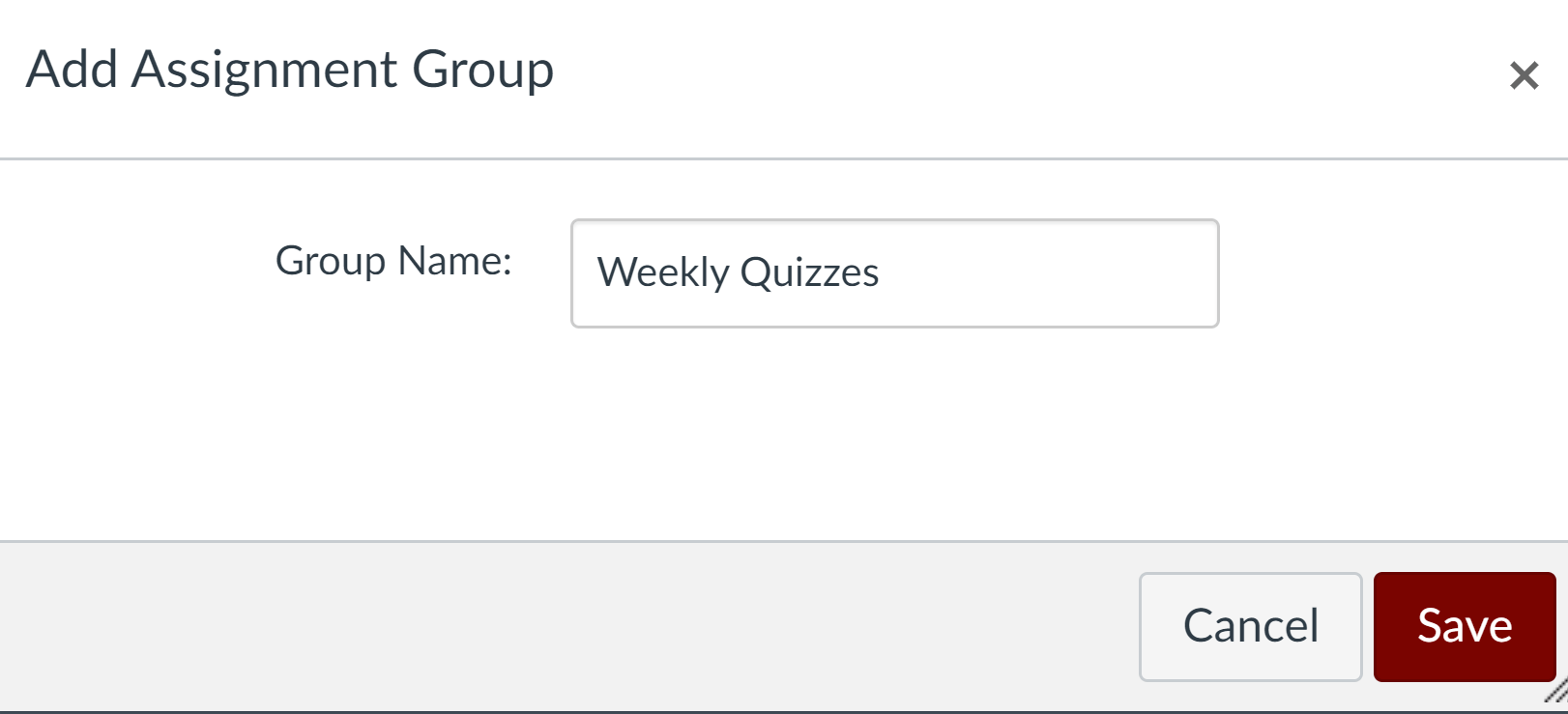
Once a group has been created, there are two ways to add assignments to it:
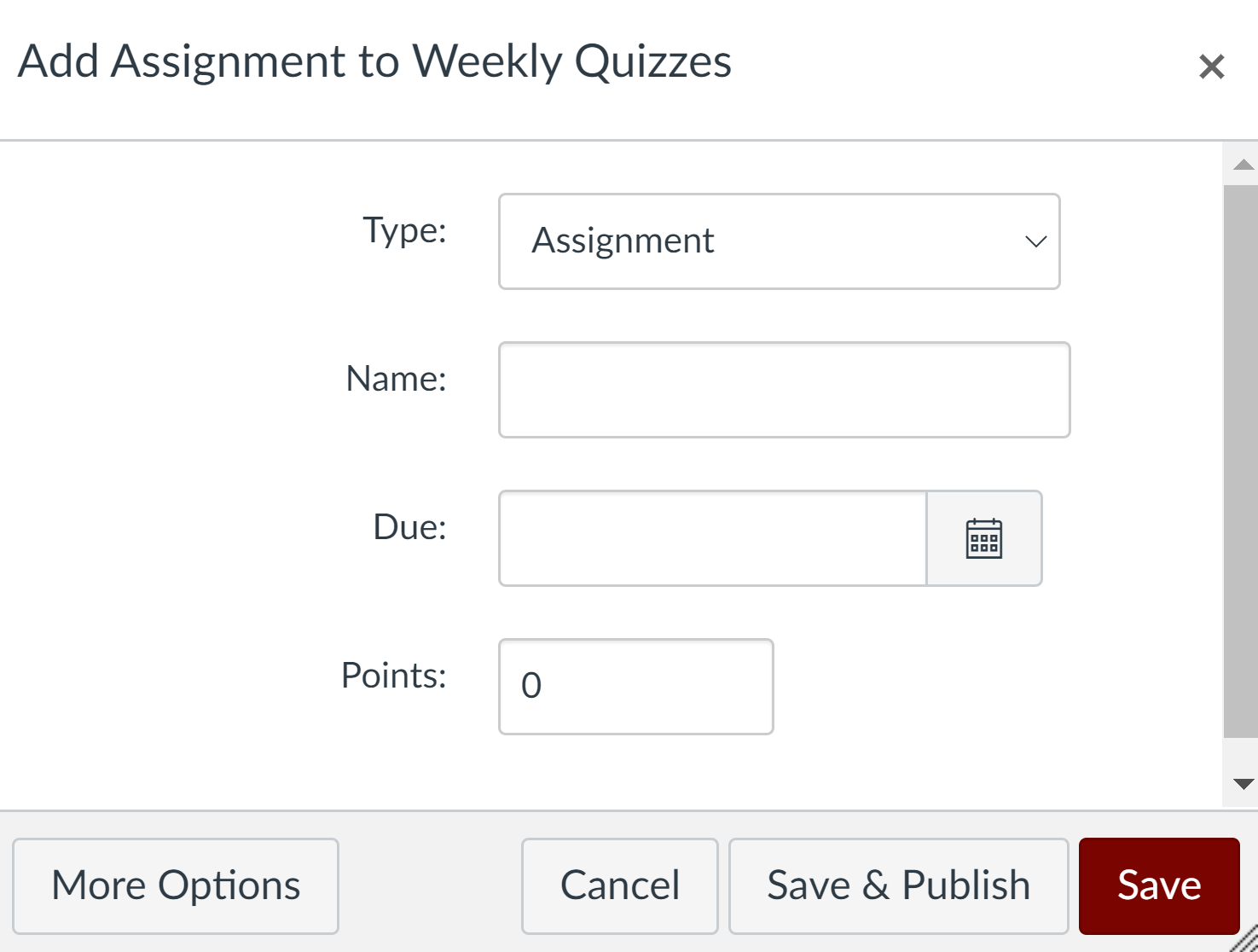
Assignment Groups are most useful when used to weight grades. With weighted Assignment Groups, you can make the organization of your assignments in Canvas match the organization used on your syllabus. You also have greater flexibility than is offered by weighting each individual assignment: if an assignment needs to be dropped or added, you can simply remove it from/add it to the appropriate assignment group, and Canvas will automatically recalculate the final grade accordingly.
For the remainder of this post, we will use as an example a course in which the grading is as follows:
- Five short quizzes: 20% of the final grade
- One midterm exam: 30% of the final grade
- One final exam: 40% of the final grade
- Attendance and participation: 10% of the final grade
To begin, the instructor creates four assignment groups, named Short Quizzes , Midterm , Final Exam , and Attendance and Participation .
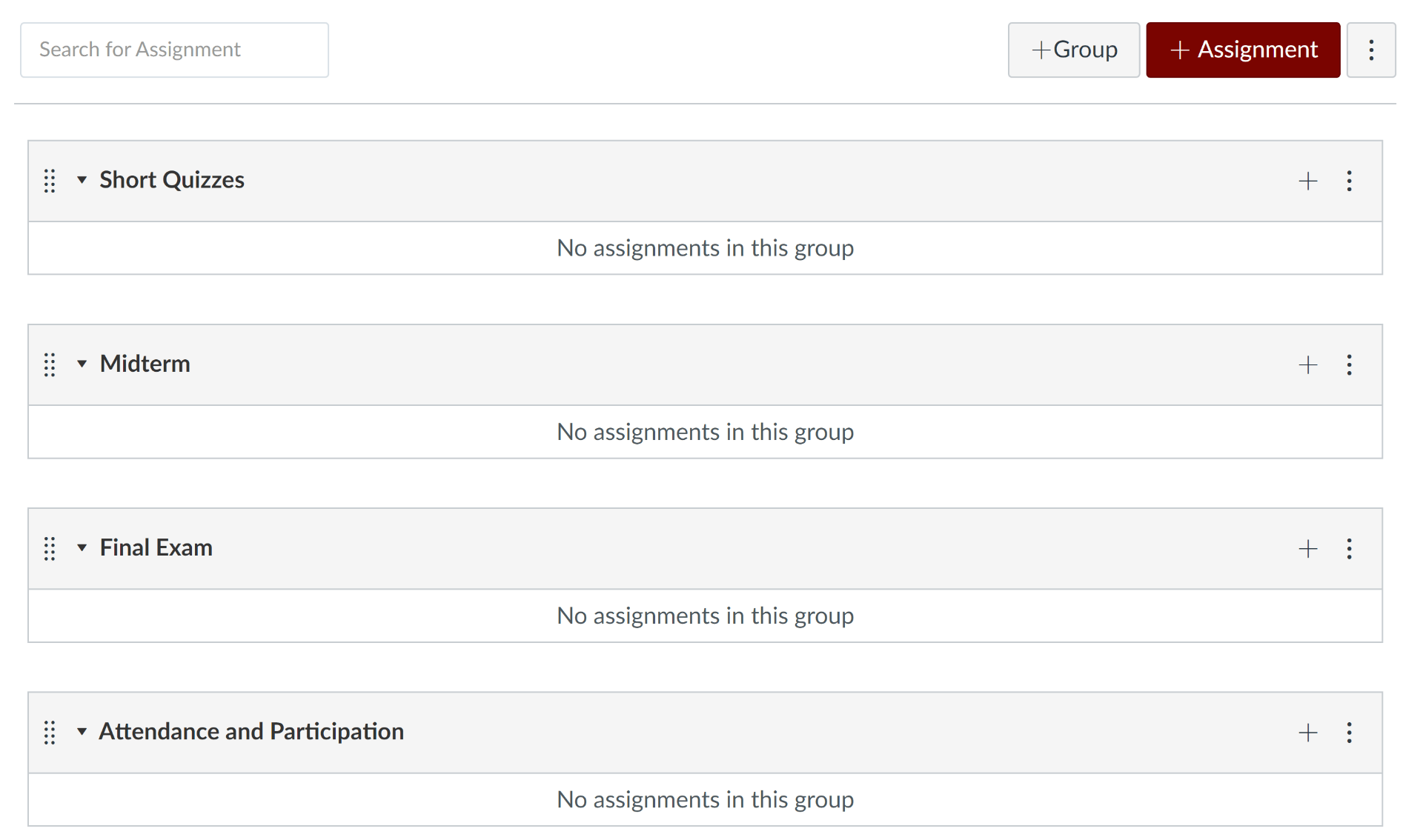
She then clicks the column of three dots at the upper right and chooses Assignment Groups Weight .
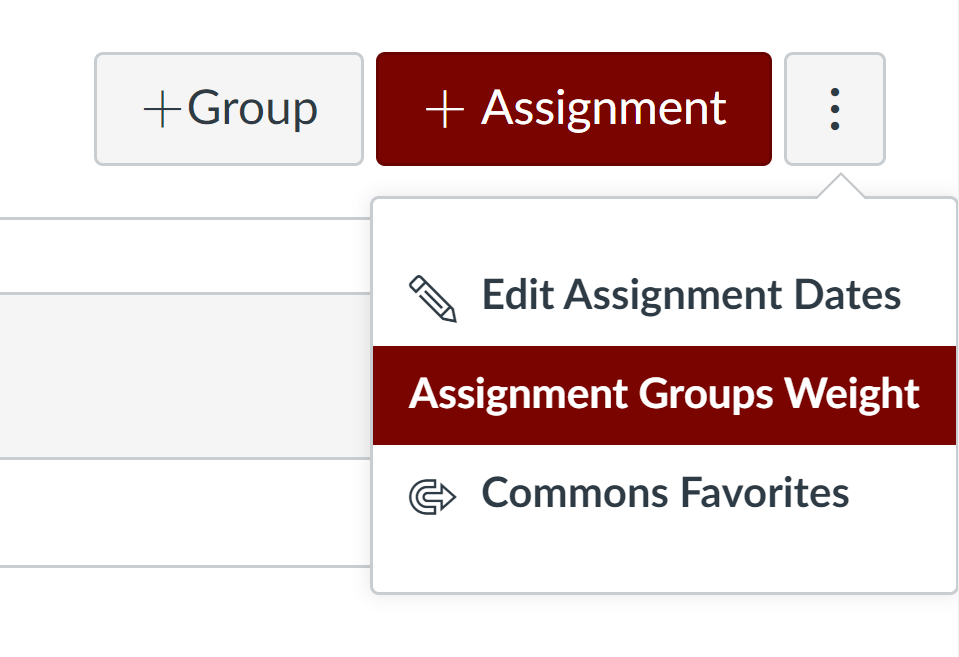
She then checks the box next to Weight final grade based on assignment groups . This allows her to set the percentage weight for each assignment group.
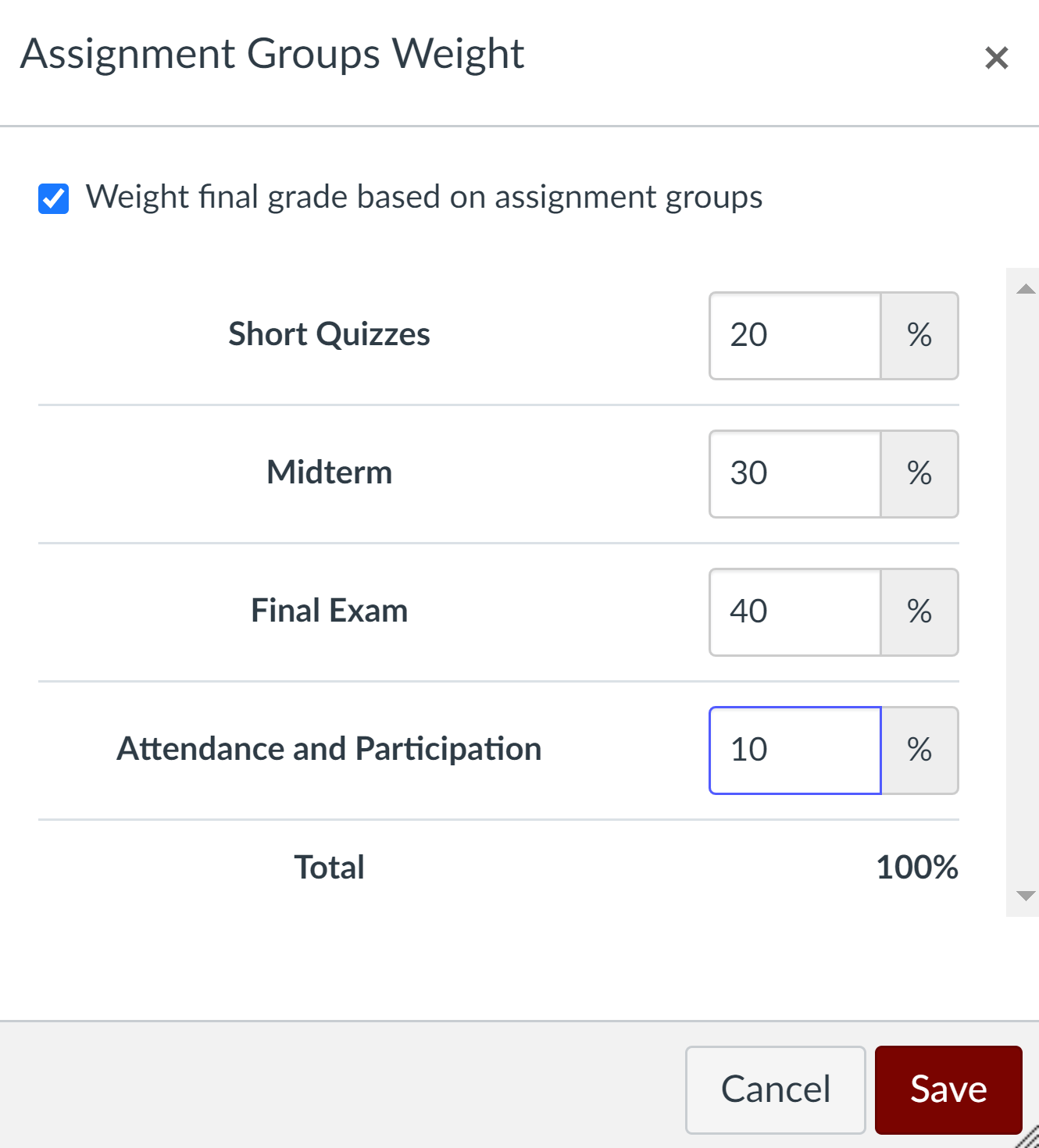
Note that Canvas shows the instructor that the assignment groups add up to 100%. It is important to check this, as Canvas will not stop you if your groups add up to less than or greater than 100%.
Once the instructor has weighted her groups to her satisfaction, she clicks the maroon Save button. Canvas then indicates across from each assignment group’s name the percentage value of the total grade that it carries.
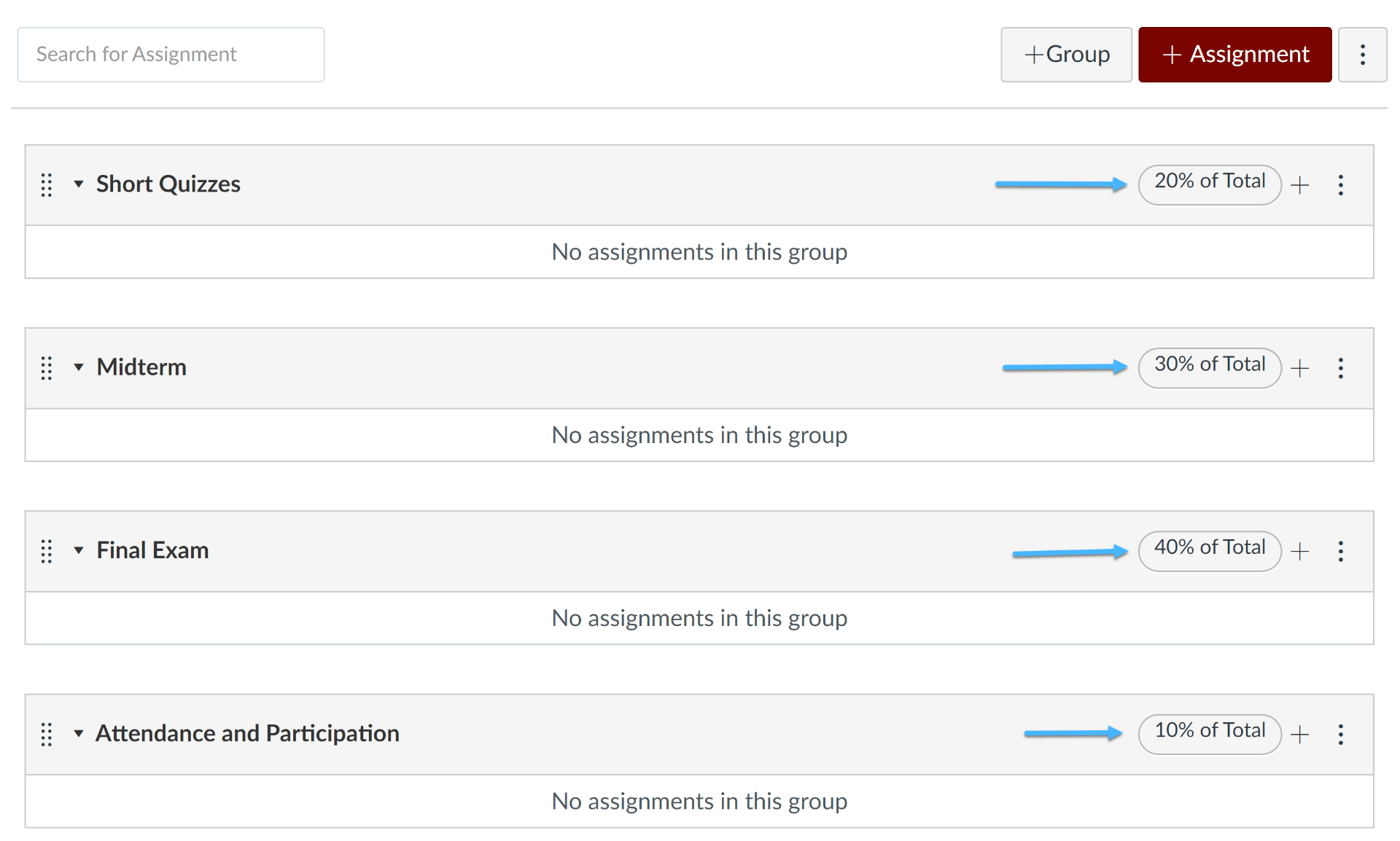
The instructor can now create her assignments and add them to the appropriate assignment groups by one of the two methods enumerated above.
An important caveat: If an assignment group contains more than one assignment, it is important that all assignments have the same point value for Canvas’ math to work out correctly. This avoids the risk of “double weighting,” which will occur if assignments within a group have different point values. For example: if a quiz worth 5 points and a quiz worth 50 points are placed in the same assignment group, the latter quiz will be worth ten times as much in Canvas’ calculations, which will greatly skew the result. In our example course, the instructor has avoided this risk by creating five quizzes within the Short Quizzes group, each of which is worth three points.
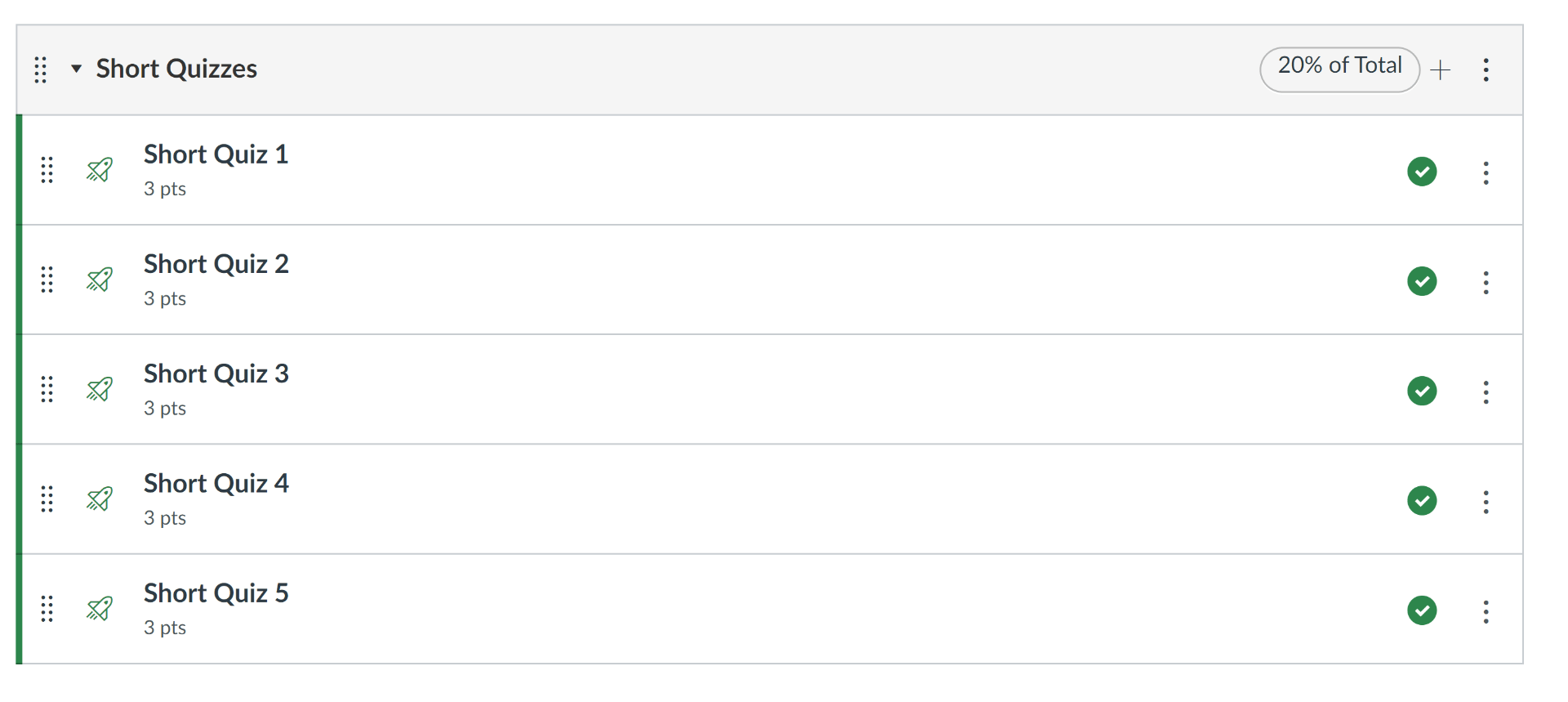
The Midterm and Final Exam groups each contain only one assignment. This can be an assignment of type Online Assignment if the instructor wishes her students to submit it through Canvas, or it can be an assignment of type On Paper if students will hand in a physical exam paper.

For the Attendance and Participation group, the instructor creates an assignment of type No Submission .

Remember that in Canvas, there is a one-to-one correspondence between assignments and columns in the Gradebook. Thus, if you wish to create a column for (e.g.) students’ attendance/participation grade, it is necessary to create a corresponding assignment. By making it of type No Submission , the instructor has ensured that students do not need to hand in any work, while still creating a Gradebook column where the grade is recorded.

Note also that if students need to submit work that will not be graded, such as an outline for an upcoming paper, you can create an assignment of submission type Online Assignment and check the box Do not count this assignment toward the final grade in the assignment options area.

Using weighted assignment groups allows Canvas to do your math for you. A column will appear in the Gradebook for each assignment group. The Total column will be calculated by multiplying the value of each column by its percentage weight and adding the results. In the case of the student below, the grade is calculated as follows:
Short Quizzes: 12 out of 15 possible points = 80 * 0.2 = 16
Midterm Exam: 90 out of 100 possible points = 90*0.3 = 27
Final Exam: 80 out of 100 possible points = 80*0.4 = 32
Attendance and Participation: 100 out of 100 possible points = 100*0.1 = 10
Total: 16+27+32+10 = 85

If you wish, you can set an assignment group to drop one or more low scores (or high scores) automatically. To do this, go to the group within the Assignments tab and click on the column of three dots across from its name to open a dialog box. Then enter the number of low or high scores you wish to drop and click Save .
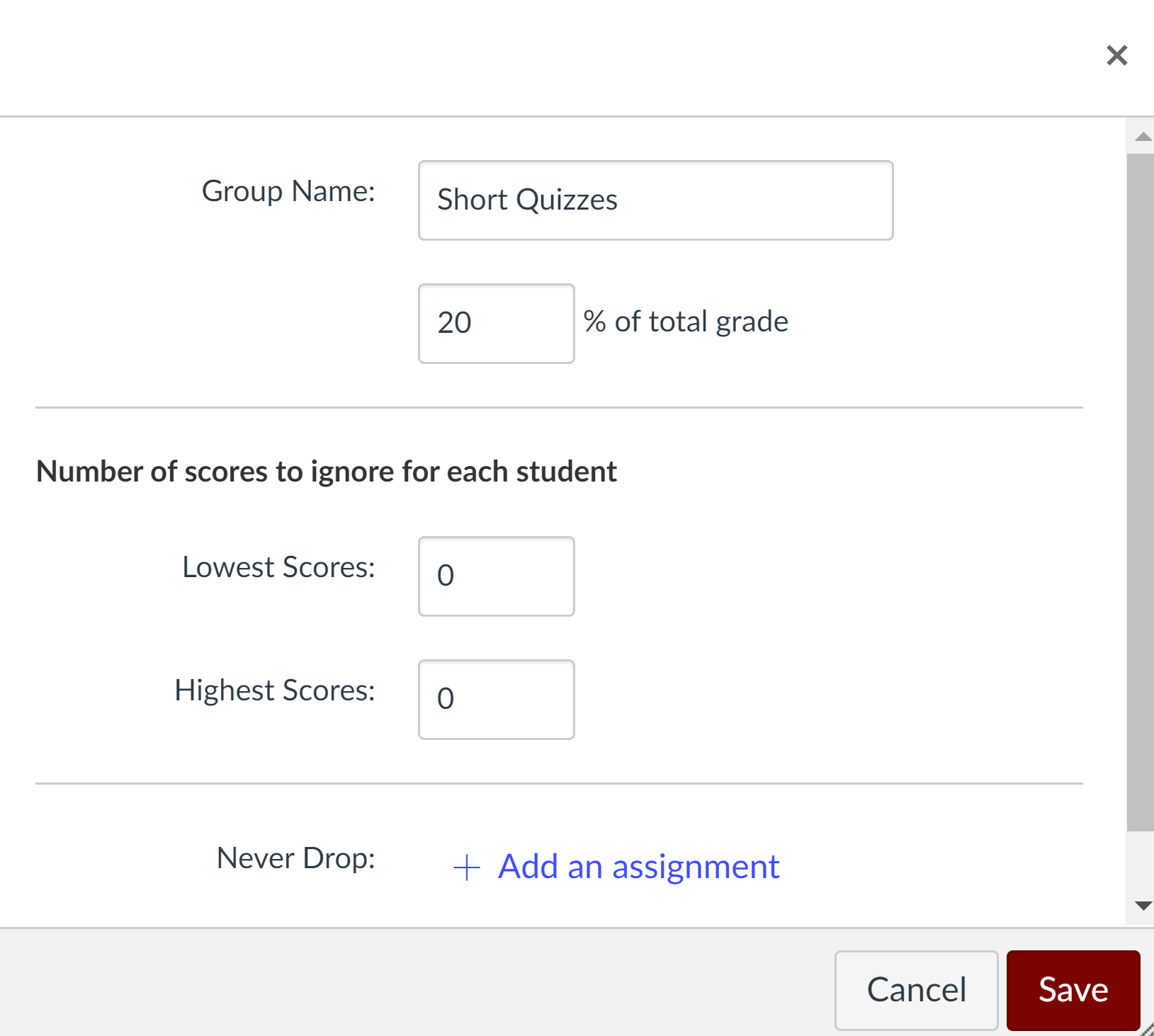
You can also specify that an assignment should never be dropped by clicking the blue +Add an assignment link next to Never drop: and choosing its name from the drop-down that appears.

For more information, please see:
- How do I weight the final course grade based on assignment groups?
- How do I create rules for an assignment group?
If you have additional questions, Academic Technology Solutions is here to help. You can attend our workshops to learn more about Canvas and other tools for teaching with technology. You can also drop into our Office Hours (virtual and in-person) to ask any questions you may have; no appointment is required.
(Cover Photo by Piret Ilver on Unsplash )
Recent Posts
- Link to Library Resources in Canvas
- Create Positive Classroom Relationships with NameCoach
- Assess the Big Picture for Your Class Using Canvas Outcomes
- Schedule Page Publication in Canvas
- Support Your Pedagogy with Anonymous Canvas Discussions
Monthly Archives
- February 2023
- January 2023
- December 2022
- November 2022
- September 2022
- August 2022
- February 2022
- October 2021
- February 2021
- January 2021
- December 2020
- November 2020
- October 2020
- September 2020
- August 2020
- February 2020
- January 2020
- December 2019
- November 2019
- October 2019
- September 2019
- February 2019
- January 2019
- December 2018
- November 2018
- October 2018
- September 2018
- August 2018
- February 2018
- January 2018
- December 2017
- September 2017
- August 2016
- October 2014
- September 2014
- Canvas Features/Functions
- Symposium for Teaching with Technology
- Teach Smart with Technology
- Uncategorized
You need to have JavaScript enabled in order to access this site.
We Trust in Human Precision
20,000+ Professional Language Experts Ready to Help. Expertise in a variety of Niches.
API Solutions
- API Pricing
- Cost estimate
- Customer loyalty program
- Educational Discount
- Non-Profit Discount
- Green Initiative Discount1
Value-Driven Pricing
Unmatched expertise at affordable rates tailored for your needs. Our services empower you to boost your productivity.
- Special Discounts
- Enterprise transcription solutions
- Enterprise translation solutions
- Transcription/Caption API
- AI Transcription Proofreading API
Trusted by Global Leaders
GoTranscript is the chosen service for top media organizations, universities, and Fortune 50 companies.
GoTranscript
One of the Largest Online Transcription and Translation Agencies in the World. Founded in 2005.
Speaker 1: Okay, a TechEduTips video. So I had an account here on canvas.instructure.com, which is a free site you can use to create your own courses in Canvas. I'm not sure what the limits are. I've used it for a bunch of tests. I use my institutional account for my main Canvas courses, but it allows me to make a test and just set things up for showing you some demos. So I created a course, TechEduTips. And what I did was I populated it with some students. I have my own domain, so I just created emails for Billy, Bobby, and Bo. And these are characters taken from our friend, Jonathan Thomas Palmer. You can see the information here on About. So Jonathan makes excellent videos, good friend. I have an interview of him on my podcast, Ask the Flipped Learning Network. So Billy, Bobby, and Bo are his students, which are, well, him. And you can see how he makes his videos. They're really amazing. And so this is just a shout out and great work that Jonathan does with his video. So I got Billy, Bobby, and Bo set up. I go to the Assignments section in my course. And this is where we're gonna lay out the design. You need to lay out what is the different weights for different buckets of your course. So if you've got an Assignments, Quizzes, Project, Exam, a very classic one. You'll note that my exam doesn't have a heavy weight. We can discuss that in pedagogy in other times or just not having exams. But that's not what we're showing today. This is a classic layout. So some of you might have this kind of layout, 50% for Assignment, 20% for Quizzes, 15% for the Project, 15% for the Exam. You might want a different weight. That's fine. We can go here and we can change the weights. It'll show you what the total is. Again, you can have buckets or categories that aren't used in the weighting scheme just for other things. Your choice, how you organize your different assignments. So this is including anything that is gradable. So it could be an assignment that's handed in. It could be a quiz. It could be what is graded forum discussions in Canvas. Anything that can have a grade in it, you can stick in the right buckets here inside of the area of assignments. Now what happens here is now that we've put these percentages here, there's other changes we can do, but I don't want to go into the details here. Let's go to grades. So this is the grades view of the teacher. So you'll notice that everything that has a value that's over there in the assignment section gets dropped in here. And then the categories are on the right and the total on the far right. Now, for example, Billy has full marks on each of these assignments. These are weighted, okay? So he's got all marks, so he's got 100% on assignments, obviously. He's got 100% on the final right now because it's not considering the other sections cuz there's nothing there. You can make changes about that, but I don't wanna go into those details right now. But this is weighted. So for example, if Billy got zero on assignment three, then he's gonna drop down to 50% in that category, because it's weighted based on the weight of each of these. Okay, there's other stuff you can do here. We can click on this little pop-up, we can change the grade, we can change the status, and you can actually change the status colors and stuff, and you can leave a comment in this section, or you can leave a comment by going to the Speed Grader section. We're not gonna talk about Speed Grader here. Just basically talking about the general view of Gradebook. So that's all I wanna show right now. I probably will do a longer series length on this with different ideas of how to use the Gradebook, how do I do grading, and see if that helps you. I would like if you could subscribe, that'll put me in your feed, and you'll see things that helps me out. And more importantly, if you wanna be alerted if there's a video, hit that bell. But I think the most important thing is to drop a comment down there in the video comments. This was useful for you if you got suggestions, especially if you have suggestions for other videos I could do. Any feedback is great. Hopefully the sound is good. I'm not blowing other people's ears out with the sound quality or the sound levels. Just give me any feedback you can, and I'm happy to make more and more videos for all of you. So thanks, have a good week, have a good evening and morning, whatever time it is that you're watching this, and keep doing great work.


Grading Teams assignments in Canvas
Microsoft Teams for Education makes it easy to grade assignments and have those grades automatically sync to your gradebook in your LMS. In Teams, you can give grades and feedback to students, set up grading categories and different grading systems, and see how your students' grades are changing over time. You can also ask students to revise their work when you provide them with feedback.
Learn more about how to grade, return, reassign, and excuse students from assignments below!
How to grade an assignment in Microsoft Teams
1. Open a class team .
2. Navigate to Assignments .
3. Choose an assignment that students have turned in.
4. Select a student's status in the Status column to open their work.

5. Review work and add comments on the document itself, where relevant. If the student submitted more than one file, you may select other files on the right to view.
Note: Can't see a file in Teams? You might have to open files created in other apps on their own. Older Microsoft Office files with .doc, .xls, and .ppt file extensions need to be edited in the desktop versions of those apps.
6. Add feedback by typing in the Feedback textbox. Attach a file by selecting Attach file or + New .
7. If you designated points for this assignment, add points in the box below the Feedback textbox.
8. If you are ready to return work to the student, select Return , or choose Return > Return for revision .
9. Use the arrows on either side of the student's name on the right to navigate from student to student.
Note: To work with less distraction, you can choose Hide pane in the bottom right corner of the grading pane. This will hide the pane, but you can still use arrows to move to other students' work and return the work by selecting Return .
10. Select Close to return to the full student list for this assignment.
Mark students as excused from an assignment
1. Repeat the above instructions for returning an assignment to multiple students or one-by-one.
2. Select the dropdown arrow next to Return , then select Return for revision .
3. Choose the option for Mark as excused and return .
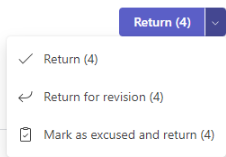
4. A dialogue box will appear asking you if you wish to mark this submission as excused. Be aware that all rubric data and points will be removed. Feedback will still be shared the student.

5. Choose the Mark as excused button.
6. Students with their assignments marked as excused will have their status changed to "Excused."

Grading multiple assignments at once
1. Navigate to a student's name in your To return list.
Tip: Select the arrow to sort students in ascending or descending alphabetical order.
2. Check the Status column to see whether students submitted a document for this assignment. It will also show you if their work is overdue, missing, or returned for revision.
3. Choose the Feedback icon next to the student's status to open a Feedback box for that student. Here you can write quick comments. Your comments will be preserved even if you navigate to another page in Teams, close the tab, or begin grading assignments individually.
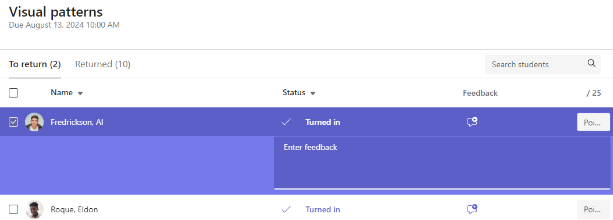
Note: If you want to attach files as feedback, you will need to grade and return assignments one-by-one . You can also take action or turn in on behalf of a student.
4. Add points in the box to the right of the Feedback textbox if you designated points for this assignment. You can add a grading scheme as well. Learn more about setting up weighted grading categories and schemes.
5. To return graded assignments to checked students, select Return or Return > Return for revision at the top. Checking feedback or grades for students checks their names. Uncheck them if you want to keep their assignments.
Note: The students you selected will receive a notification that their assignment has been returned. Their name will now show up in the Returned list. Their assignment status in the Grades tab will update, too.
Grade a group assignment
If you've created group assignments, give a group grade or give individual grades to members of the group.
After you have opened the assignment, you will notice each group and its members in your to return tab.
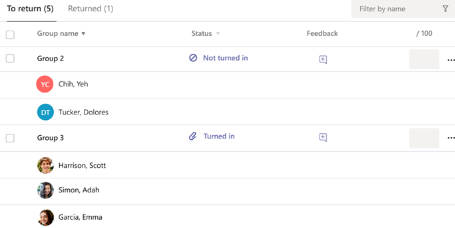
Grade and return multiple group assignments at once
1. Navigate to a group in your to return list.
Tip: Select the arrow to sort groups in ascending or descending alphabetical order.
2. Check the Status column if groups turned in a document with this assignment. You will also see if their work is late, not turned in, or returned for revision.
3. Select the Feedback icon to open a Feedback box for that group, then add comments. Your comments will be saved even if you go to another page in Teams, close the tab, or start grading assignments one-by-one.
4. Add points in the box to the right of the Feedback textbox if you designated points for this assignment.
Note: If you would like to give group members individual grades instead, select More options in the group's row, then Grade students individually .
5. Choose Return, return for revision , or Mark as excused and return at the top of the page to send back graded assignments to the checked groups.
When you give a grade or feedback to a group's assignment, the checkbox next to their name is marked. You can unmark those checkboxes if you want to save a group's assignment for later.
Note: The students in the groups you selected will receive a notification that their assignment has been returned or if they have been marked as excused. Their name will now show up in the Returned list. Their assignment status in the Grades tab will update, as well.
Video feedback
1. Choose an assignment.
2. Select a student from the list.
3. The student's assignment will open. Navigate down to the Feedback section.
4. Choose the camera icon to open a video meeting.
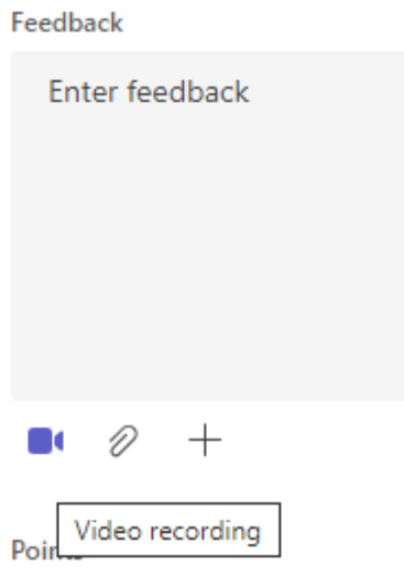
5. With the video window open, press the center button to both record and stop the recording .
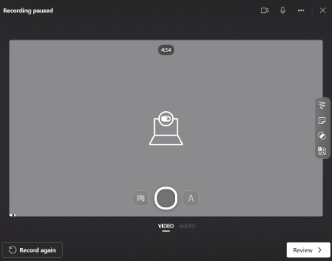
6. When finished, choose the Review button to view the recording. If you approve, move on by selecting the Next button.
7. A file name for the recording is required to upload it. The file will be saved as a .webm extension.
8. Choose the Upload button.
9. Once the video has been uploaded, select the Done button to complete video feedback.
Return as assignment for revision
1. Select a student’s status in the Status column to open their work.
2. Select the dropdown arrow next to Return .
3. Choose the option for Return for revision .
The assignment of the student will appear in your Returned list, and they will see Needs revision. The student will receive a message to edit their assignment and submit it again.
Tip: If you want to change the deadline for receiving turn-ins, you can do it at any time by selecting the assignment and then choosing More options > Edit . Choose Edit assignment timeline under the due date and time, and then adjust it.
Set up weighted grading categories
1. Navigate to your desired class team and select the Grades tab.
2. Select the Assignments settings icon.
3. Scroll to Grade settings and toggle Weighted grading categories to On .
4. A Manage grading categories window will appear. Select Add grading category.
5. Name your grading category and enter the percentage you'd like to assign as that category's weight.
6. Repeat for each desired grading category.
7. When you've finished adding your categories select Save .
Note: Percentages must add up to 100% to move on.
8. In grade settings, your grading categories and percentages are now visible. To edit, select Manage grading categories .
9. Now you can select a grading category each time you create an assignment.
Important: In classes using grading categories, any assignment with points must have a grading category.
Assignments and grades in your class team
Grade, return, and reassign assignments
Track student progress in the Grades tab
Create and manage grading rubrics in Microsoft Teams

Need more help?
Want more options.
Explore subscription benefits, browse training courses, learn how to secure your device, and more.

Microsoft 365 subscription benefits

Microsoft 365 training

Microsoft security

Accessibility center
Communities help you ask and answer questions, give feedback, and hear from experts with rich knowledge.

Ask the Microsoft Community

Microsoft Tech Community

Windows Insiders
Microsoft 365 Insiders
Was this information helpful?
Thank you for your feedback.

COMMENTS
Assign Different Dates for Groups. By default, the assignment is assigned to everyone in your course. To add different due and availability dates for specific groups or users in your course, click the Add Assign To button [1]. Then start to type part of the group name in the new Assign To field [2]. Click the group's name when it appears [3].
This tutorial will show you how to set up your Assignment Categories in Canvas. This is essential if you are using Skyward as a gradebook and you want your g...
#3: In this video, I cover how to create Assignment Groups (Categories) in Canvas; as well as assigning each category a percentage. This video is Part 3 of ...
This video will show how to create Assignment Categories in Canvas. This is necessary to ensure that your grades will pass to Skyward correctly.Before comple...
Canvas Groups are a way for instructors to organize students within a course for group assignments, group discussions, or other collaborative work. The Groups tool creates course-like areas in Canvas that include the following navigational options: Figure: Sample Group space in Canvas. A Group Set is a collection of groups.
As a best practice, you should 1st create Assignment Groups before adding your assignments in Canvas. Select the "Assignments" tab from your Course Navigation menu; Select "+Group" Create and name each assignment group; Once you create all assignment groups, you'll need to add Assignment Group Weights. Select the dropdown button next to red ...
How Do I Use Assignment Groups in Canvas? In Canvas, assignment groups allow you to organize your assignments into discrete groups. For example, you may want to group all the essay assignments in your course within one assignment group titled 'Essays'. Assignment groups allow you to leverage a weighted grade scheme in your Canvas course. A weighted grade scheme allows you to distribute ...
The first step is to click People. . Click Groups. Click + Group Set. Type the assignment or project name in Group Set Name box.. Let's have Canvas automatically create groups for us. Select Split students into groups.. You can determine how many groups you would like. . Scroll down and click Save.
The Assignments page is arguably the most central to successful Canvas course utilization. It controls the columns in the gradebook and gradebook calculations. It displays all things gradable, including assignments, gradable discussions, and quizzes. Each can be created in Assignments. Dates used in the syllabus and calendar are rapidly edited ...
You can create assignments on your calendar, on the modules page, or on the assignments page. Let's create one on the assignments page. Click Assignments. 2. Click the Add Assignment icon. 3. Here you'll enter some basic information to get started. Begin by typing a Name for your assignment.
Create Assignment Group. Type the Assignment Group Name in the Group Name field [1]. If you want to weight the final grade for students using assignment groups, the percentage will appear in % of total grade field [2]. Note: You must create assignment groups before you can assign percentages to each group.
Edit the Group Name and % of total grade in their respective boxes.; Enter the number of scores to drop from each student's final grade in the Lowest Scores and Highest Scores boxes.; In the Never Drop section, click Add an assignment to include one or more assignments in the final grade regardless of score.; To reorder an assignment group in the Assignments page, click and drag the assignment ...
2. Click "+Assignment" at the top right. 3. Write the assignment title and directions for students. 4. Assign the number of points available for the assignment. 5. Choose an "Assignment Group". Assignment groups are, in essence, a category of assignment. For more information about using Assignment Groups, see the Canvas guides regarding ...
Once you have added assignments to your assignment group, you can create rules for the entire assignment group. Assignment group rules determine how Canvas handles any exceptions you want to create for grade calculations. Assignment groups can be weighted or unweighted. When using the lowest or highest score rule, an assignment group must ...
Canvas Assignments are a way for instructors to provide students opportunities to practice using the knowledge and skills they have gained or to assess student performance related to such knowledge and skills. (Creating an Assignment is the only way to create a new column in the Gradebook.) In Canvas there are four basic Submission Types for ...
This is a short video showing you how to change assignment groups in Canvas to match up with assignment types in SIS so you can import into those categories....
To Assign Weights to Assignment Groups in Canvas: On the "Assignments" page, click the 3 dots in the upper right-hand corner of the page, and click "Assignment Groups Weight". Check the box next to "Weight final grades based on assignment groups". Specify the percentage for each Assignment Group, then click "Save.".
A second common source of confusion is how to create gradebook columns. In Canvas, assignments are tightly integrated with the Gradebook and the only way to create a gradebook column is to create and publish an assignment.This may seem unintuitive at first glance, as not all assignments require online submissions (e.g. attendance and participation or assignments done on paper).
Simply choose the desired assignment type from the drop-down next to Type. Create the assignment first by clicking the maroon +Assignment button at the upper right. The assignment will appear in the default Assignments group. You can then move it to another assignment group by clicking on the double column of dots next to its name and dragging ...
My Dashboard; Pages; Groups and Group Assignments; Demo Term. Home; Modules
Setting Up Assignments in Canvas . Assignments in Canvas should include complete instructions, attachments, due dates, rubrics, etc. for the assignment. The student should not have to go back to the syllabus for information to complete the assignment. Step by step instructions are below. Open Assignments . In Course Navigation, click the ...
How to set up your grade book in Canvas in a few simple steps. You'll learn how to add grade and assignment categories, how to weigh assignment categories i...
Again, you can have buckets or categories that aren't used in the weighting scheme just for other things. Your choice, how you organize your different assignments. So this is including anything that is gradable. So it could be an assignment that's handed in. It could be a quiz. It could be what is graded forum discussions in Canvas.
In Canvas courses, final grades can be weighted by organizing assignments into groups and then designating a percentage to indicate the weight of each assignment group within the final grade calculation. Creating Assignment Groups. To create a new assignment group, first open Assignments. Click the +Group button to create a new assignment group.
2. Check the Status column if groups turned in a document with this assignment.You will also see if their work is late, not turned in, or returned for revision. 3. Select the Feedback icon to open a Feedback box for that group, then add comments. Your comments will be saved even if you go to another page in Teams, close the tab, or start grading assignments one-by-one.